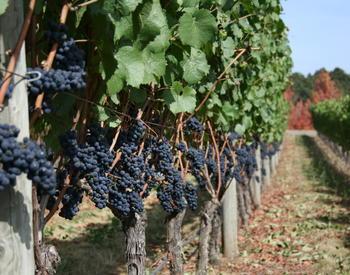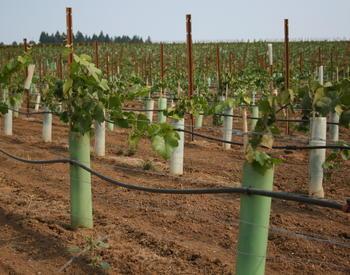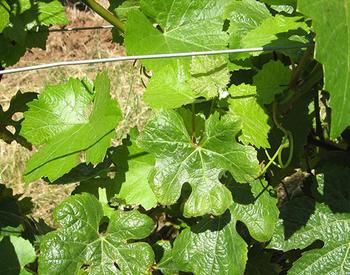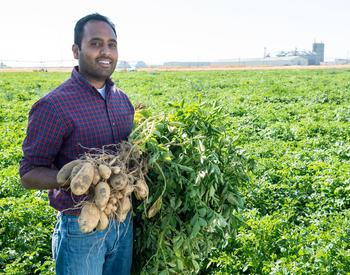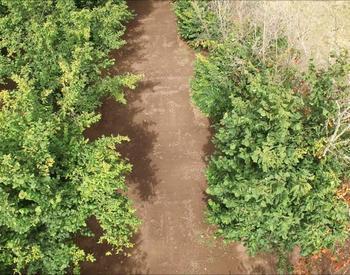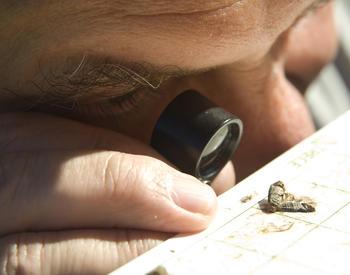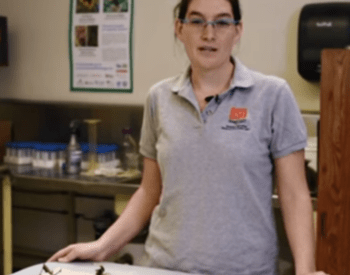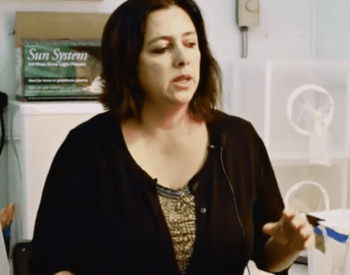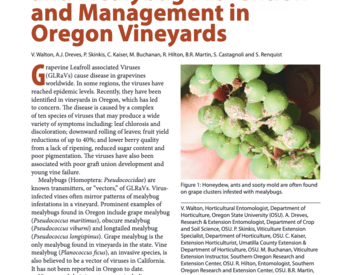What is grapevine red blotch disease?
Grapevine red blotch disease (GRBD) is caused by a virus known as grapevine red blotch virus (GRBV). It was first described on Cabernet Sauvignon in Napa Valley in 2008 but has since been identified in many U.S. wine production regions, including California, Idaho, North Carolina, New York, Missouri, Ohio, Oregon and Washington. There are 86 different viruses known to infect grapevines, more than any other perennial crop, and grapevine red blotch virus is only one of them.
Although recently identified, GRBV has likely been present for ~6,000 years, with the US as its epicenter. The disease causes leaves to become red and blotchy (in red-fruited varieties) or chlorotic and yellow (in white-fruited varieties). The disease may delay or hamper fruit ripening, reducing wine quality for some varieties and in some regions. Additional symptoms descriptions are available in the further-reading section below.
How does the disease spread?
Pathologists believe that an insect vector may spread the virus, but none has been found to cause spread in commercial vineyards. The three-cornered alfalfa hopper, Virginia creeper leafhopper and a few other leafhopper species were found to transmit the virus in controlled-lab or greenhouse studies. In Oregon, two leafhopper species, Euscelis variegatus and Dikraneura absenta, were found to transmit GRBV to clean vines under greenhouse transmission studies. These species were found most abundantly in non-vineyard areas surrounding the vineyard and not in the vineyard or vine canopy.
Further studies continue across the U.S. to investigate other treehopper and leafhopper species and other insects found in and around infected vineyards to determine which may be causing virus spread. Insecticide use is not recommended at this time to reduce these insect populations in and around infected vineyards.
Humans are the primary virus vector to date, as virus-infected plant material used during propagation and planting is still the number one cause of virus introduction into vineyards.
Prevention and monitoring
It is best to avoid the virus by using "clean" plant material (i.e., bud wood or plants). Clean vines are those that have been tested and confirmed to be free of the virus and any other important viruses that plague grapevines.
You can obtain clean plants by purchasing "certified" plant materials from nurseries or source plants that have been rigorously tested and confirmed free of the virus or other concerning viruses. Below are additional considerations for preventing the virus in vineyards:
1) New vineyard plantings
When establishing a new vineyard, buy only certified (or virus-tested) plants. Be sure to inquire with the nursery or supplier as to whether the plants you are buying are certified and/or have been tested for grapevine red blotch virus or other important viruses.
Certification refers to vines originating from a virus-free mother block that was established with vines from an official state certification program.
Note that all plant material coming into the state of Oregon currently must be tested for grapevine red blotch virus and grapevine leafroll associated virus and confirmed free of the viruses or come as certified stock. After January 2023, all vines coming into the state must be certified. This is to help reduce the spread of the virus.
2) Grafting over
When grafting a new cultivar in an established vineyard, be sure to source clean bud wood by purchasing certified (virus-free) bud wood and/or test source vineyards for the virus.
Secondly, ensure that the vines you are grafting are not infected by testing them for the virus. Grapevine virus testing is available at commercial labs (see list below). See observed virus below for timing.
3) Observed virus
If you suspect that your vineyard has the virus, mark and monitor symptomatic vines. Symptoms typically are visible during late summer to fall.
Take detailed notes on when you first observe symptoms (date and the vine growth stage), and monitor and record changes in symptoms over time. Test symptomatic vines for the virus by submitting tissues for analysis.
It is also good to test asymptomatic vines in the same block to determine if there may be healthy vines present as well. See virus-testing labs below, and check the lab sampling protocols before collecting and submitting samples.
Researchers note that it is best to use dormant tissue in winter, selecting basal cane positions near the cordon/cane/trunk for testing. Sampling dormant tissues during winter will give you the greatest opportunity to detect the virus if it is present.
Sampling leaf tissue early in spring or summer (even late summer) will have a high likelihood of not detecting the virus, resulting in false negative results.
4) Confirmed virus
If you have infected vines, consider removing them, especially in young plantings. Early detection and plant removal in young vineyards has been shown to reduce the spread of the virus. Before removing infected vines, consider the economic impact on your vineyard. The article by Ricketts et. al 2017 in the American Journal of Enology and Viticulture has economic-based rogue and replant scenarios.
5) Testing for the virus
When testing plants for the virus, it is important to test for multiple viruses (often are called "virus panels" by testing labs). This is highly recommended to determine which virus may be causing issues, as there are several viruses that may cause similar symptoms (e.g., grapevine leafroll associated virus).
Virus testing labs on the West Coast (alphabetical order)
- Agri-Analysis
- AL&L Lab
- California Seed & Plant Lab
- Eurofins STA Laboratories
- OSU Plant Clinic
- WSU Plant Pest Diagnostic Lab
- Wonderful Laboratories
Further reading
See the resources below for further information about the disease.
- Grapevine red blotch disease: A comprehensive Q & A guide
- Grapevine Red Blotch Disease — Oregon Department of Agriculture
- Red Blotch Information Fact Sheet — National Clean Plant Network
- Grapevine Red Blotch Disease — PNW Plant Disease Handbook
- Increasing Accuracy of Sampling for Red Blotch Disease - Dr. Achala KC, plant pathologist, OSU
- Oregon Grape Quarantine — Oregon Department of Agriculture
Red blotch research
Use the resources below to learn more about research in progress
- Grapevine red blotch disease: A comprehensive Q & A guide
- Oregon Wine Research Institute Red Blotch Study Team
- Grapevine Red Blotch – What You Need to Know (webinar)
- California Department of Food and Agriculture research proceedings (Red Blotch research reports are included in 2015-2021)
- UC-Davis Research Team working on Three-Cornered Alfalfa Hopper
- Mitigating Grape and Wine Quality Impacts of Red Blotch Wine Business
Published research from Oregon
- Epidemiology of Grapevine Red Blotch Disease Progression in Southern Oregon Vineyards
- Water Deficits Do Not Improve Fruit Quality in Grapevine Red Blotch Virus-Infected Grapevines (Vitis vinifera L.)
- Irrigation Improves Vine Physiology and Fruit Composition in Grapevine Red Blotch Virus-Infected Vitis vinifera L.
- Cluster Thinning Does Not Improve Fruit Composition in Grapevine Red Blotch Virus infected Vitis vinifera L.
- Composition of Pinot Noir Wine from Grapevine Red Blotch Disease-Infected Vines Managed with Exogenous Abscisic Acid Applications
